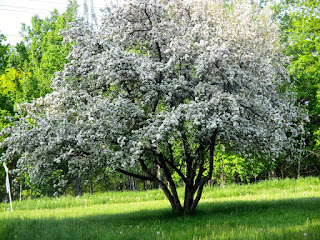Tuesday, May 30, 2017
CRABAPPLES HAVE BEGUN TO BLOOM
Tuesday, 8:30 AM. 48 degrees F at both the ferry dock and on the back porch. Wind SSW, light to moderate with stronger gusts. The sky is cloudy and overcast and it may rain. The humidity is 78%, the barometer steady for now, at 29.82". The skies will clear some and we will have highs around 70 Wednesday and Thursday, then temperatures will drop to around 50 with rain again on the weekend.
The cool, damp spring continues. It was not a particularly harsh or long winter, but spring just hasn't sprung, resulting in a fabulous season for bulbs and a slightly later but still nice season for everything else.
The crabapples and apples are starting to bloom in profusion, but my pocket camera has finally worn out and I am relying on photos from my archives until I can replace it tomorrow.
The parent species of both crabapple and edible apple, Malus sylvestris, in the Rose Family, has been hybridized, by both nature and by man, to such an extent that it is quite difficult to determine where one starts and the other leaves off, but suffice it to say that crabapples generally are ornamentals with small fruits, and apples are grown for their edible fruits. Both are typically grafted to retain their particular hybrid or varietal characteristics. The Malus gene pool is very plastic, yielding an endless variety of genetic combinations and traits. There are many hundreds of varieties of apples and almost as many of crabapples, so it doesn't pay to try to go into much descriptive detail here about them.
From an ornamental standpoint. crabapples are available in so many sizes, shapes and colors, etc. and are so tough and hardy that if one is diligent the right tree can be found for almost any landscape and garden niche.
The fruits of crabapples are as varied as the blossoms, and should be taken into consideration when choosing a variety to plant. There are a few crabapples, such as the 'Whitney,' that have fruits considered to be edible, or at least suitable for canning. All crabapples are good wildlife food, and none are poisonous. They are tolerant of many soil conditions, but require full sun.
Subscribe to:
Post Comments (Atom)













No comments:
Post a Comment